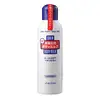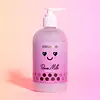What's inside
What's inside
 Key Ingredients
Key Ingredients

 Benefits
Benefits

 Concerns
Concerns

 Ingredients Side-by-side
Ingredients Side-by-side

Water
Skin ConditioningGlycerin
HumectantParaffinum Liquidum
EmollientButylene Glycol
HumectantCetyl Oleate
EmollientUrea
BufferingDimethicone
EmollientCetearyl Alcohol
EmollientPetrolatum
EmollientGlyceryl Stearate
EmollientPEG-60 Glyceryl Isostearate
Glycine
BufferingStearic Acid
CleansingIsostearic Acid
CleansingBehenic Acid
CleansingPotassium Carbomer
Emulsion StabilisingSodium Citrate
BufferingPotassium Isostearate
Potassium Behenate
CleansingMenthol
MaskingEDTA
Sodium Paraben
PreservativeWater, Glycerin, Paraffinum Liquidum, Butylene Glycol, Cetyl Oleate, Urea, Dimethicone, Cetearyl Alcohol, Petrolatum, Glyceryl Stearate, PEG-60 Glyceryl Isostearate, Glycine, Stearic Acid, Isostearic Acid, Behenic Acid, Potassium Carbomer, Sodium Citrate, Potassium Isostearate, Potassium Behenate, Menthol, EDTA, Sodium Paraben
Water
Skin ConditioningSodium Laureth Sulfate
CleansingCocamidopropyl Betaine
CleansingLauryl Glucoside
CleansingGlycerin
HumectantSodium Chloride
MaskingSodium Hyaluronate
HumectantAloe Barbadensis Leaf Juice
Skin ConditioningPanthenol
Skin ConditioningGlycol Stearate
EmollientPotassium Sorbate
PreservativeSodium Benzoate
MaskingMalva Sylvestris Extract
AstringentHedera Helix Extract
AntimicrobialCucumis Sativus Fruit Extract
EmollientSambucus Nigra Flower Extract
RefreshingArnica Montana Flower Extract
MaskingPhenoxyethanol
PreservativeCaprylyl Glycol
EmollientTetrasodium EDTA
Parfum
MaskingCI 17200
Cosmetic ColorantCI 16035
Cosmetic ColorantCI 15985
Cosmetic ColorantWater, Sodium Laureth Sulfate, Cocamidopropyl Betaine, Lauryl Glucoside, Glycerin, Sodium Chloride, Sodium Hyaluronate, Aloe Barbadensis Leaf Juice, Panthenol, Glycol Stearate, Potassium Sorbate, Sodium Benzoate, Malva Sylvestris Extract, Hedera Helix Extract, Cucumis Sativus Fruit Extract, Sambucus Nigra Flower Extract, Arnica Montana Flower Extract, Phenoxyethanol, Caprylyl Glycol, Tetrasodium EDTA, Parfum, CI 17200, CI 16035, CI 15985
 Reviews
Reviews

Ingredients Explained
These ingredients are found in both products.
Ingredients higher up in an ingredient list are typically present in a larger amount.
Glycerin is already naturally found in your skin. It helps moisturize and protect your skin.
A study from 2016 found glycerin to be more effective as a humectant than AHAs and hyaluronic acid.
As a humectant, it helps the skin stay hydrated by pulling moisture to your skin. The low molecular weight of glycerin allows it to pull moisture into the deeper layers of your skin.
Hydrated skin improves your skin barrier; Your skin barrier helps protect against irritants and bacteria.
Glycerin has also been found to have antimicrobial and antiviral properties. Due to these properties, glycerin is often used in wound and burn treatments.
In cosmetics, glycerin is usually derived from plants such as soybean or palm. However, it can also be sourced from animals, such as tallow or animal fat.
This ingredient is organic, colorless, odorless, and non-toxic.
Glycerin is the name for this ingredient in American English. British English uses Glycerol/Glycerine.
Learn more about GlycerinWater. It's the most common cosmetic ingredient of all. You'll usually see it at the top of ingredient lists, meaning that it makes up the largest part of the product.
So why is it so popular? Water most often acts as a solvent - this means that it helps dissolve other ingredients into the formulation.
You'll also recognize water as that liquid we all need to stay alive. If you see this, drink a glass of water. Stay hydrated!
Learn more about Water